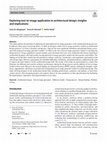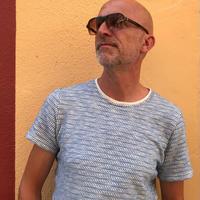Papers by Donia M Bettaieb
The international journal of architectonic, spatial, and environmental design, Dec 31, 2022

Architecture, Structures and Construction
This study explores the potential of employing AI, particularly text-to-image generators, in the ... more This study explores the potential of employing AI, particularly text-to-image generators, in the architectural design process. It addresses three main research questions: (1) How do designers utilize text-to-image generative models in architectural design practices? (2) From a designer's perspective, what are the most significant limitations and potential threats associated with using text-to-image generative models? (3) What is the role of text-to-image generative models in enriching the design process? Using a qualitative research method, semi-structured interviews were conducted with sixteen experienced architectural designers who had recently incorporated text-to-image generative models into their practice and toolkits. The findings reveal that these models have the potential to enhance creativity, visualization, and imagination, particularly in the early design stages. However, participants also identified difficulties, limitations, and potential threats, emphasizing the need to improve the tools further to fit the architectural design field. The results of this study are demonstrated as a matrix that illustrates the different tools used by architects and designers during the design process and the addition of text-to-image models to these tools. Moreover, the research findings are summarized using a SWOT analysis, outlining the strengths, weaknesses, opportunities, and threats associated with incorporating text-to-image generative models in architectural design. This study will help designers in the architectural design field, including professionals, academics, and students, to boost their creative process when designing projects and empower them to be more productive in their specializations by facilitating the augmentation, exploration, and experimentation of new ideas.
The International Journal of Design Management and Professional Practice

Proceedings of DARCH 2022- 2nd International Conference on Architecture & Design, Mar 21, 2022
Different sources of inspiration influence the generation of ideas during the design process diff... more Different sources of inspiration influence the generation of ideas during the design process differently. In this study, we compare the influence of the two modes of representation of external stimuli, picture vs. text, on the conceptual design process in the idea generation phase. We analyse how these two types of inspiration sources affect the development and outcomes of the ideation process. We collected data during a workshop with twenty-four senior-level interior design students at King Abdul-Aziz University. We gave the participants an exploratory design problem to solve involving the design of a college residency room for two people. Some participants received stimuli in the form of text and others in the form of images. The participants' outcomes for the task were assessed under the conditions of the two modes of representation by external judges. The study also analysed participants' responses to a questionnaire about their experience during the experiment, their relevant opinions, and problems they encountered, if any. The results indicate that compared to the use of text, the use of pictures to activate the inspiration process helped participants produce complex thinking, original solutions, and the use of drawing for idea generation.

Open House International
PurposeStudies related to biophilic design (BD) have not clarified the user's role in applyin... more PurposeStudies related to biophilic design (BD) have not clarified the user's role in applying its elements and features to improve quality of life (physical and mental health). This paper aims to highlight the users' role (experience, practice, and advice) when utilising aspects of BD in the interior environment of modern houses (MH) in Jeddah, Saudi Arabia, as a case study.Design/methodology/approachA study of users' experiences was conducted through a qualitative approach by analysing semi-structured one-to-one interviews with a representative sample from Jeddah (12 heads of the family) using an adapted Biophilic Interior Design Matrix. An inductive approach was applied by extrapolating the users' role in employing BD elements in the MH's interior environment based on their experience in employing various biophilic elements.FindingsThe findings demonstrate the importance of the user's role when incorporating biophilic elements in living spaces. The levels ...

International Journal for Educational Integrity, 2022
This study aims to remove some of the ambiguities of visual plagiarism in interior design (those ... more This study aims to remove some of the ambiguities of visual plagiarism in interior design (those related to the visual composition of space represented by line, form, shape, texture, time, colour, light, etc.) by examining the main detection methods, the extent of the issue, and the experiences and roles of academic interior designers. Two main methods were used: an analysis of the primary forms of visual plagiarism and an applied approach to test the effectiveness of plagiarism. Additionally, 30 academics in the Kingdom of Saudi Arabia, who majored in interior design, were surveyed using an online questionnaire. The results demonstrated that changing the light and colour while maintaining the rest of the properties and changing the line, form, and shape are considered visual plagiarism. However, the results also indicated that visual plagiarism is not always clear for academics. It is hoped that the results of this study will increase the awareness of visual plagiarism, enhance eth...

International Journal of Multidisciplinary Studies in Heritage Research, 2022
Purpose: Traditional houses in the Historic District of Jeddah exhibit architectural characterist... more Purpose: Traditional houses in the Historic District of Jeddah exhibit architectural characteristics that reflect an important aspect of the social practices of the area in various historical contexts. This study aimed to clarify the link between the principles and characteristics of material cultural heritage (architectural characteristics) and a set of social practices, such as celebrations, that took place in the houses of the historical region of Jeddah. Furthermore, the study provided design guidelines for contemporary homes to support the social practices of celebrations in a modern context. These guidelines hope to preserve cultural stock and protect the traditional homes in the historical region of Jeddah from destruction. Design/methodology/approach: The study used the descriptiveanalytical method to characterize and analyse the architectural characteristics and social practices of well-known occasions in the region. Moreover, tangible and intangible heritage was investigated by employing the principles of design to elements of contemporary homes.

Arts and Humanities in Higher Education, 2021
Design spaces can be read in two complementary structural and compositional dimensions: the impli... more Design spaces can be read in two complementary structural and compositional dimensions: the implicit dimension, and the formal dimension. This study aimed to answer the following questions: What are the phases of the original idea transformation in the design process? Does taking advantage of the implicit dimension of others’ interior spaces count as inspiration or plagiarism? Participants comprised nine postgraduate students, who were asked to copy others’ project ideas by applying four design phases: idea source, test, choice, and output. The results showed that plagiarism of the concept of others’ work could not occur unless the concept copies the structural, functional, and aesthetic aspects of the design space at the level of its components and the relationships between them. Otherwise, taking advantage of the implicit dimension of others’ project ideas can be an inspiration. The results are expected to increase awareness among interior design instructors in higher education.

The interior design project teaching is a complex process, especially if we consider the "de... more The interior design project teaching is a complex process, especially if we consider the "design process" nature that contain so many difficulties facing the teacher when issuing Scientific / Education system and Communicational framework, where interactive relationship combines teacher-learner inside the studio interior design. Those difficulties has been revealed throughout preliminary studies. In this context, this paper aims to reflect basic concepts problem in interior design project teaching and fundamental considerations of educational framework. The main purpose of this reflection is elaborated on two levels: Level one: to evoke a bunch of "design act" reference concepts considered as essential to communicate the "design process" fundamentals. Level two: to address educational framework peculiarities of the interior design teaching project, out of a set of data which is limited in the practical reflection in interior design teaching. This paper ...
The International Journal of Design Education, 2021

International Journal of Innovation and Applied Studies, 2017
The design process is the main central concern in design research. It has been considered as a so... more The design process is the main central concern in design research. It has been considered as a solving problem, as discussed recently by many researchers. Nevertheless, this process could be approached by the theory of complexity. Knowing this latter have different understandings and implications, we can consider the designing as a complex system. However, this approach leads us to think about the different levels of complexity linked to the design product production. In this context, we are often targeting the designer rather than the product itself; or being focused on one aspect to the detriment of another (creativity, problem solving …); or somewhat developing a different process (the process of problem evolution or solution evolution or their coevolution). Regarding process design, it appears too much coherent if we think that it is so complex and almost impossible to pin point and treat everything as unit. Nonetheless, when we go deeply through Edgar Morin writings and his approach of "Complex Thinking" or even "Global Thinking", we are conducted necessary to perceive the design process differently, from global rethinking point of view. To rethink of it as a complexus. The impact of such an initial approach will be discussed. So, the trends in design research will be reviewed in a first section, We will develop, in a second one, a thinking particular mode of the design process with reference to Edgar Morin's approach.

Archnet-IJAR: International Journal of Architectural Research, 2020
PurposeThe COVID-19 pandemic resulted in the compulsory quarantine of many of the world's inh... more PurposeThe COVID-19 pandemic resulted in the compulsory quarantine of many of the world's inhabitants, and by staying at home, several functional developments emerged in residential spaces in Jeddah that affected the role of the house as a contributor to individuals' quality of life under the pressures of quarantine. Given the necessity of the apartments to adapt to these emerging developments, this study explores the determinants associated with the flexibility of residential apartments by looking at the extent to which they meet the new psychological, social and cultural roles required by their users post-COVID-19.Design/methodology/approachThe qualitative approach (1) extracted concepts related to the flexibility of housing from the available literature and (2) extrapolated the flexibility of the residential apartments from the participants' study (12 families) in different areas of Jeddah by analyzing the results of targeted interviews.FindingsThere is a gap in the p...

Art and Design Review, 2020
This study aims to investigate the attitudes of students towards environmental sustainability. To... more This study aims to investigate the attitudes of students towards environmental sustainability. To identify their level of concern for the environment and the impact of the academic year on their attitudes towards environmental sustainability, a quantitative approach was adopted using a cross-sectional survey. A questionnaire was distributed to (N = 78) interior design students at King Abdulaziz University (KAU) in Jeddah. Interior design students responded to a three-part survey including demographic characteristics, ecology and environmental sustainability, and comments. The results revealed that students' level of interest in the environment was moderate and that their attitudes were generally positive and moderately pro-environmental. In general, there was understanding and awareness among students regarding the problems related to nature as well as a lack of accuracy of the information they obtained. Although the results also showed students' understanding of the use of sustainable products and solutions in interior design scenarios, there was a clear lack of actual uses of these products and solutions in student projects, and there was a gap between what students said about what they were doing in their project and what they actually applied in their design projects. Finally, the results indicated that the attitudes and perceptions of the students surveyed regarding environmental sustainability did not actually depend on the specialization variable or the level of the study. Through a deeper application of the fundamentals of responsible design, it is shown that enthusiastic and conscientious students can be guided towards environmental sustainability and achieve exciting results. The results of this study will help to raise awareness of interior design educators about students' attitudes towards environmental sustainability. The results also illustrate the importance of following the application of sustainability requirements in interior design projects and of not limiting student exposure.

Art and Design Review, 2018
Developing a design for a domestic space is associated with the evolution of the needs of both in... more Developing a design for a domestic space is associated with the evolution of the needs of both individuals and societies. Hence, the problem has emerged through multiple different types, names, various considerations of its design and many dimensions associated with it, including psychological, social, cultural and economic dimensions. The purpose of this study is to establish a conceptual frame for design considerations regarding domestic space emerges, with the determination of the common constants between different types of domestic space, and reorganizing these constants so an interior designer can apply them can help achieve the desired physical and psychological comfort for the users. This can only occur if we consider that achievement of the physical and psychological comfort for the users is usually a result of the efficiency of design of the Functionality and Aesthetic System of space.

Art and Design Review, 2017
During foundation stages, interior design students are faced difficulties in mental perception of... more During foundation stages, interior design students are faced difficulties in mental perception of the relationship between matching two-dimensional drawings and expressive design ideas, especially when designing compositions and building relationships between design elements. The purpose of this study is to determine what is the teaching strategy that enables students to perceive relations between ideas of design and their foundations of projection during the foundation stage? The researcher has come up with basic steps enabling students to project their design's ideas easily. Each stage of these stages is dependent on self-assessment criteria, certified as a reference, to be assigned to students and allow them to link the theoretical findings with practical work. The purpose of this study is to determine what is the teaching strategy that enables students to perceive relations between ideas of design and their foundations of projection during the foundation stage? The researcher has come up with three basic steps enabling students to project their design's ideas easily, and gradually perceives the concept of building relationships between the design's idea and foundations of their projections in the foundation stage. These steps are represented in the stage of sketching the composition prior to their embodiment (cutting paper template), the stage of alternate adjustment of embodiment and sketching, and finally the stage of sketching composition after their embodiment.
International Design Journal

Journal of Visual Art and Design
Studies on the processes that link logos and space design aesthetics to visual perception and rec... more Studies on the processes that link logos and space design aesthetics to visual perception and recognition of visual brand identity (VBI) remain scant. Consequently, this study analyzed the visual correspondence between visual brand identity elements such as logos and interior spaces in commercial retail banking companies by assessing the foundations of their aesthetics formation and the role of aesthetic principles, aesthetic appraisal, and aesthetic impression. Using a qualitative approach, four commercial retail banking companies in Jeddah, Saudi Arabia were analyzed through semi-structured interviews with professional designers and design academics. A comparative method was used to determine the visual correspondence between the aesthetics of the logos and the interior spaces. The findings confirmed the importance of using design characteristics and theories for designing the elements of VBI. The results encourage the use of design for building visual correspondence between the e...

International Journal of Structural and Civil Engineering Research, 2019
In the field of interior design, materials are considered of the most important elements that pla... more In the field of interior design, materials are considered of the most important elements that play a vital role in the functionality of internal spaces. The selection of these materials according to clear criteria is considered one of the most important inputs guaranteeing the project's success and practical efficiency. In this context, this study aims to look into the general criteria for the selection of a material according to previous studies, in order to explore and clarify the special criteria that should be adopted and implemented when selecting materials in the internal design project. This research work is mainly due to the researchers' observation of an evident lack in the quantity of information on the selection criteria of materials in the field of interior design, whereas most of what has been reported in numerous related studies are information only showing the technical properties of the material, thus qualitatively limiting the designer's choices and the application of his creative ideas. This research in previous studies showed that there are general criteria for materials, which are essentially artistic, technical, functional, aesthetic, economic and environmental, that should be considered when choosing the material as a design element. This research also concluded the special criteria for the selection of materials as a design element and as an element listed as part of a group of elements that constitute a comprehensive aesthetic functional system reflecting solutions for the interior environment, which, in turn, reflects a range of sensory effects emanating through the material, shape, texture and color. It is expected for the results of this research to assist those who work in the field of interior design from the academics who teach this discipline, the students, as well as the professional working at consulting and executive offices in the labor market, by providing them with the selection criteria for materials in interior design projects.

International Journal of Structural and Civil Engineering Research, 2019
In the field of interior design, materials are considered of the most important elements that pla... more In the field of interior design, materials are considered of the most important elements that play a vital role in the functionality of internal spaces. The selection of these materials according to clear criteria is considered one of the most important inputs guaranteeing the project's success and practical efficiency. In this context, this study aims to look into the general criteria for the selection of a material according to previous studies, in order to explore and clarify the special criteria that should be adopted and implemented when selecting materials in the internal design project. This research work is mainly due to the researchers' observation of an evident lack in the quantity of information on the selection criteria of materials in the field of interior design, whereas most of what has been reported in numerous related studies are information only showing the technical properties of the material, thus qualitatively limiting the designer's choices and the application of his creative ideas. This research in previous studies showed that there are general criteria for materials, which are essentially artistic, technical, functional, aesthetic, economic and environmental, that should be considered when choosing the material as a design element. This research also concluded the special criteria for the selection of materials as a design element and as an element listed as part of a group of elements that constitute a comprehensive aesthetic functional system reflecting solutions for the interior environment, which, in turn, reflects a range of sensory effects emanating through the material, shape, texture and color. It is expected for the results of this research to assist those who work in the field of interior design from the academics who teach this discipline, the students, as well as the professional working at consulting and executive offices in the labor market, by providing them with the selection criteria for materials in interior design projects. Index Terms-materials selection criteria, Interior spaces, Materials, Interior design, Design projects.











Uploads
Papers by Donia M Bettaieb